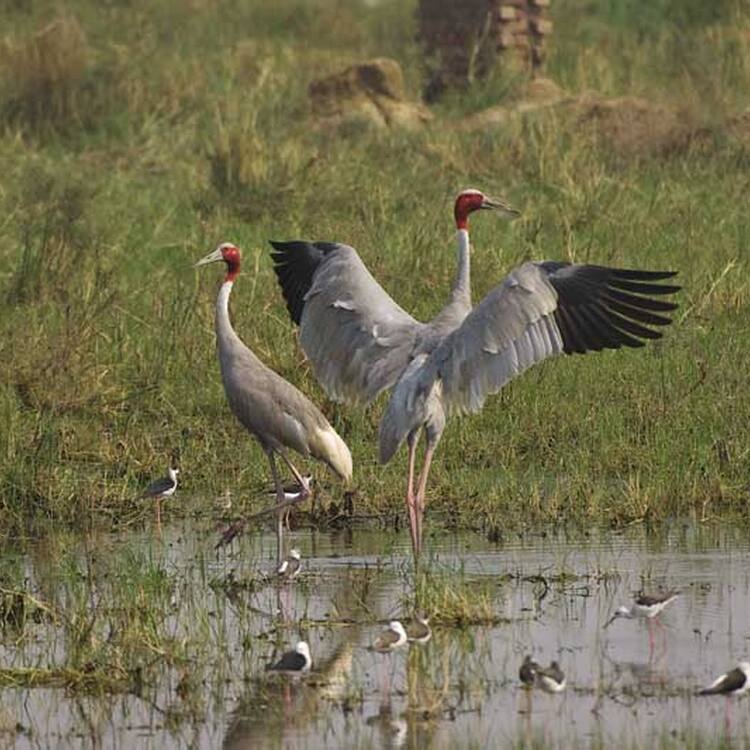Keoladeo National Park
Keoladeo National Park
This former duck-hunting reserve of the Maharajas is one of the major wintering areas for large numbers of aquatic birds from Afghanistan, Turkmenistan, China and Siberia. Some 364 species of birds, including the rare Siberian crane, have been recorded in the park.
Description is available under license CC-BY-SA IGO 3.0
Parc national de Keoladeo
Ancienne réserve princière de chasse au canard, le parc national de Keoladeo reste un lieu d'hivernage majeur pour des myriades d'oiseaux d'eau venus d'Afghanistan, du Turkménistan, de Chine et de Sibérie. On y a dénombré 364 espèces d'oiseaux, dont la rare grue sibérienne.
Description is available under license CC-BY-SA IGO 3.0
روضة كيولاديو الوطنية
لا يزال منتزه كيولاديو الوطني، وهو محمية أميرية قديمة لصيد الأوزّ، مكاناً هاماً لقضاء فصل الشتاء يقصده سرب من الطيور المائية القادمة من أفغانستان وتركمنستان والصين وسيبيريا. وأُحصيت أجناس الطيور ب 364 جنساً يُذكر بينها طير الكُركيّ السيبيري.
source: UNESCO/CPE
Description is available under license CC-BY-SA IGO 3.0
凯奥拉德奥国家公园
凯奥拉德奥国家公园位于默哈拉杰。以前这里是猎鸭地区,现在是大批水禽鸟类冬季栖息的重要地区。这些水禽来自阿富汗、土库曼斯坦、中国和西伯利亚。364种鸟在公园里已经记录在册,其中包括稀有的西伯利亚鹤。
source: UNESCO/CPE
Description is available under license CC-BY-SA IGO 3.0
Национальный парк Кеоладео
Эти бывшие охотничьи угодья махараджи, преобразованные затем в охраняемую территорию, служат одним из важнейших мест зимовки для огромного числа перелетных околоводных птиц из Афганистана, Туркмении, Китая и Сибири. Приблизительно 364 вида птиц, включая редкого сибирского журавля, зарегистрировано на территории парка.
source: UNESCO/CPE
Description is available under license CC-BY-SA IGO 3.0
Parque nacional de Keoloadeo
Antiguo coto de caza de patos de los marajás, este parque es una de los más importantes lugares de invernada para un sinfín de aves acuáticas que emigran desde Afganistán, Turkmenistán, China y Siberia. Entre las 364 especies registradas figuran algunas tan poco comunes como la grulla siberiana.
source: UNESCO/CPE
Description is available under license CC-BY-SA IGO 3.0
ケオラデオ国立公園
source: NFUAJ
Nationaal park Keoladeo
Source: unesco.nl
केवलादेव राष्ट्रीय उद्यान
महाराजाओं का यह पूर्व बत्तख-शिकार रिजर्व अफगानिस्तान, तुर्कमेनिस्तान, चीन और साइबेरिया से बड़ी संख्या में जलीय पक्षियों के लिए प्रमुख शीतकालीन क्षेत्रों में से एक है। दुर्लभ साइबेरियन क्रेन सहित पक्षियों की लगभग 364 प्रजातियों को पार्क में देखा गया है।
Source: India
Outstanding Universal Value
Brief synthesis
Keoladeo National Park, located in the State of Rajasthan, is an important wintering ground of Palaearctic migratory waterfowl and is renowned for its large congregation of non-migratory resident breeding birds. A green wildlife oasis situated within a populated human-dominated landscape, some 375 bird species and a diverse array of other life forms have been recorded in this mosaic of grasslands, woodlands, woodland swamps and wetlands of just 2,873 ha. This ‘Bird Paradise’ was developed in a natural depression wetland that was managed as a duck shooting reserve at the end of the 19th century. While hunting has ceased and the area declared a national park in 1982, its continued existence is dependent on a regulated water supply from a reservoir outside the park boundary. The park’s well-designed system of dykes and sluices provides areas of varying water depths which are used by various avifaunal species.
Due to its strategic location in the middle of Central Asian migratory flyway and presence of water, large congregations of ducks, geese, coots, pelicans and waders arrive in the winter. The park was the only known wintering site of the central population of the critically endangered Siberian Crane, and also serves as a wintering area for other globally threatened species such as the Greater Spotted Eagle and Imperial Eagle. During the breeding season the most spectacular heronry in the region is formed by 15 species of herons, ibis, cormorants, spoonbills and storks, where in a well-flooded year over 20,000 birds nest.
Criterion (x): The Keoladeo National Park is a wetland of international importance for migratory waterfowl, where birds migrating down the Central Asian flyway congregate before dispersing to other regions. At time of inscription it was the wintering ground for the Critically Endangered Siberian Crane, and is habitat for large numbers of resident nesting birds. Some 375 bird species have been recorded from the property including five Critically Endangered, two Endangered and six vulnerable species. Around 115 species of birds breed in the park which includes 15 water bird species forming one of the most spectacular heronries of the region. The habitat mosaic of the property supports a large number of species in a small area, with 42 species of raptors recorded.
Integrity
This is the only park in India that is completely enclosed by a 2 m high boundary wall that minimises the possibilities of any encroachment and biotic disturbances, but there is no possibility of a buffer zone. As the wetlands of Keoladeo are not natural, they are dependent on the monsoon and on water pumped in from outside, traditionally provided from the “Ajan Bandh” reservoir. The water shortage caused by the erratic rainfall in the region is being addressed by initiating two large water resources projects that will bring water from permanent water sources in the region. There has been some concern expressed over possible air and water pollution effects from the adjacent city of Bharatpur, but these effects are unknown at present.
Through eco-development activities in the surrounding villages, the grazing of cattle within the park has been minimised and the local communities are also engaged in participatory resource conservation, which includes removal of invasive alien species. Keoladeo attracts many visitors who are taken for bird watching in bicycle rickshaws by trained local guides from surrounding villages, which provides additional livelihoods as well as reduces noise pollution.
A recently started conservation programme for the 27 satellite wetlands surrounding this park has further enhanced the protection of the migratory waterfowl arriving in the Central Asian flyway to winter in Western India.
Protection and management requirements
The property has effective legal protection under the provisions of Wildlife (Protection) Act, 1972 and Indian Forest Act, 1927. The site is managed by the Rajasthan Forest Department with the support of local communities and national and international conservation organizations, and a management plan has been developed for the protection and management of the property.
The major threats to the property are the water supply (both quantity and quality); invasive vegetation (Prosopis, Eichhornia, Paspalum); and inappropriate use of the property by neighbouring villages. These issues are being dealt with through the management plan, and two projects have been developed to bring a permanent solution to the water crisis. Invasive alien species have been removed through cooperative arrangements with the surrounding populations. The 2 m high boundary wall that surrounds the park virtually eliminates the threats of poaching or pollution, and there is no encroachment or habitations inside the park. Noise pollution from the adjoining Bharatpur city and National Highway are minimal. Due to stringent legal environmental regulations in India, all proposed developmental activities have to be subjected to a stringent environmental assessment process.


